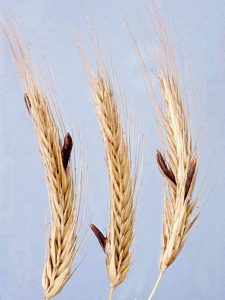What if one bite of warm, freshly-baked bread could kill you? Where, even before you realize you’ve become a victim of ergotism, you start to feel nauseous and noticeably numb.
But… then that brings us to the question…
What Exactly is Ergotism?
Ergotism is a disease caused by a fungus called ergot (scientific name: Claviceps). Often found growing on cereal and forage plants like grass, wheat and rye, ergots can be deadly if ingested. When ingested, it can cause symptoms like seizures, nausea, and hallucinations and cut off a person’s blood flow; possibly leading to death.

Ergots on rye. Fortunately easy to differentiate from regular rye grains due to the difference in colour and size. Source from The Atrium
Because ergots grow on forage plants such as wheat and rye, they can easily be ingested by a large population: infected crops can be processed into flour, a common ingredient used in multiple cuisines, and contaminate the food people will consume. As a result, ergotism epidemics have caused the deaths of many people throughout history; a single case in 944 France caused the deaths of 40,000 people.
Further records of these epidemics date back as early as the Middle Ages; maybe even before then.

A depiction of ergotism found on the painting ‘The Temptation of St Anthony’ (1512-1516) by Matthias Grünewald. Ergotism is also known as St. Anthony’s Fire. Source from Brewminate.
Nowadays, as knowledge on ergots advances, the number of reported deaths caused by ergotism has greatly decreased. Regulations have been placed on agricultural and milling procedures to prevent ergots from being milled into flour. Additionally, specific farming methods have been devised to prevent ergots from growing on the crops altogether.
Although… are ergots really so harmful?
Beneficial Uses of Ergots
Despite the toxic properties, scientists have discovered ways to use ergots in beneficial ways by creating multiple compounds derived from the toxins produced by ergots.
One of these compounds is ergotamine; a medicine used to treat migraines-type headaches. Ergotamine works by utilizing the properties of ergots that can restrict blood flow by narrowing the blood vessels around the brain and reducing the headaches caused by changes in those blood vessels.
Another compound derived is ergometrine, also known as ergonovine; a medicine used to induce labour and prevent postpartum bleeding. Similar to ergotamine, ergometrine uses the properties of ergots that reduce blood flow and narrow blood vessels to reduce blood loss after birth.

Chemical structure of the compound, ergometrine. Illegal in the United Kingdom based on its close relations with LSD. Source from Wikipedia
With that said, there are risks and side effects to both of these compounds. An overdose of either compound can cause ergotism and possible side effects of ergometrine include vomiting and high or low blood pressure. Because of these risks, they’ve been heavily regulated; ergometrine especially because it can also be used to make LSD. Both these compounds aren’t for daily use and should only be used if prescribed by a medical professional.
The use of ergot-based compounds as medicine is a heavily debated topic. Some people argue that the safety concerns are far too great to ignore while others argue we can’t ignore the benefits either.
Whether you are against ergot-based medicines or not, it’s fascinating to see how much impact a small fungus, not much longer than a child’s pinky finger, has on our history… and perhaps, our future as well.
– Christine Sun

One response to “From Poison to Prescription: The Large Impact of a Small Fungi”